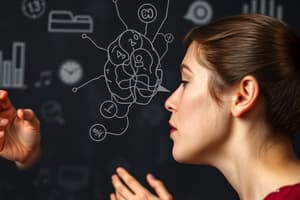Podcast
Questions and Answers
What is the primary mechanism through which children learn from their elders?
What is the primary mechanism through which children learn from their elders?
- Trial and error
- Direct instruction
- Modeling (correct)
- Conditioning
What does cognitive learning primarily involve?
What does cognitive learning primarily involve?
- Observational learning
- Physical practice
- Emotional responses
- Acquiring new information (correct)
How do consumers demonstrate stimulus generalization?
How do consumers demonstrate stimulus generalization?
- They only respond to brand names they recognize.
- They learn specific behaviors for each individual store.
- They disregard past experiences and start anew.
- They instinctively repeat responses to similar stimuli. (correct)
In marketing, what is a common strategy to encourage stimulus generalization?
In marketing, what is a common strategy to encourage stimulus generalization?
Which of the following best describes modeling in the context of learning?
Which of the following best describes modeling in the context of learning?
What type of cigarette is described as appealing to the independent, rugged, adventuresome man?
What type of cigarette is described as appealing to the independent, rugged, adventuresome man?
In classical conditioning, what is necessary for the pairing to be effective?
In classical conditioning, what is necessary for the pairing to be effective?
What principle does Skinner's pigeon experiment illustrate?
What principle does Skinner's pigeon experiment illustrate?
What type of reward is given externally to the product in marketing?
What type of reward is given externally to the product in marketing?
What happens if a product is not intrinsically rewarding to the consumer?
What happens if a product is not intrinsically rewarding to the consumer?
Why do consumers learn to buy and use products with intrinsic rewards?
Why do consumers learn to buy and use products with intrinsic rewards?
Which of the following is an example of an intrinsic reward?
Which of the following is an example of an intrinsic reward?
What is the effect of consumer patronage gained through extrinsic rewards like giveaways?
What is the effect of consumer patronage gained through extrinsic rewards like giveaways?
What is the primary function of stimulus discrimination in consumer behavior?
What is the primary function of stimulus discrimination in consumer behavior?
Which type of memory is responsible for processing currently relevant information?
Which type of memory is responsible for processing currently relevant information?
What best characterizes episodic knowledge?
What best characterizes episodic knowledge?
How is information transferred from short term memory to long term memory?
How is information transferred from short term memory to long term memory?
What type of memory specifically involves the properties of objects?
What type of memory specifically involves the properties of objects?
Which of the following examples illustrates stimulus discrimination in marketing?
Which of the following examples illustrates stimulus discrimination in marketing?
What is the role of encoding in the memory process?
What is the role of encoding in the memory process?
Which type of knowledge includes information about events witnessed by others?
Which type of knowledge includes information about events witnessed by others?
What primarily influences consumers' decision to adopt an innovation based on how much better it is compared to existing products?
What primarily influences consumers' decision to adopt an innovation based on how much better it is compared to existing products?
Which factor describes the uncertainty consumers feel about an innovation's benefits and potential harms?
Which factor describes the uncertainty consumers feel about an innovation's benefits and potential harms?
What does complexity in the context of innovation adoption refer to?
What does complexity in the context of innovation adoption refer to?
Which element is crucial for a product to gain faster adoption due to its visibility and social communicability?
Which element is crucial for a product to gain faster adoption due to its visibility and social communicability?
What does behavioral compatibility ensure when consumers consider adopting an innovation?
What does behavioral compatibility ensure when consumers consider adopting an innovation?
Which factor does trialability specifically relate to in the context of innovation adoption?
Which factor does trialability specifically relate to in the context of innovation adoption?
What concept explains why consumers may reject an innovation if it conflicts with their core values or attitudes?
What concept explains why consumers may reject an innovation if it conflicts with their core values or attitudes?
What is indicated when consumers have a fondness for innovations from previous eras while also appreciating current technology?
What is indicated when consumers have a fondness for innovations from previous eras while also appreciating current technology?
What is the purpose of rehearsal in memory retention?
What is the purpose of rehearsal in memory retention?
Which technique uses nonsensical associations to aid memory?
Which technique uses nonsensical associations to aid memory?
How does elaboration improve memory retention?
How does elaboration improve memory retention?
What distinguishes recognition from recall in terms of memory retrieval?
What distinguishes recognition from recall in terms of memory retrieval?
Which of the following best describes aided recall?
Which of the following best describes aided recall?
What is unaided recall?
What is unaided recall?
In what context would the external stimulus enhance memory retrieval?
In what context would the external stimulus enhance memory retrieval?
Which of the following statements about memory techniques is true?
Which of the following statements about memory techniques is true?
Flashcards are hidden until you start studying
Study Notes
Classical Conditioning
- Pairing a stimulus with a desired response: When a brand wants to elicit a positive response in the consumer, they pair the brand with a desired stimulus, such as color, look, feel of the ad, scenery, music, objects, or sound bits.
- Example: Calvin Klein perfume is associated with youth because of the teenage models used in the ad.
Instrumental Learning
- Skinner's Pigeons: Pigeons learned to peck at the correct door to receive food.
- Instrumental Learning: Learning a behavior because it's rewarding.
- Rewards: Marketers use two forms of rewards to make consumers learn to buy their products.
- Extrinsic Rewards: External to the product, such as coupons, rebates, and loyalty programs.
- Intrinsic Rewards: Built into the product, such as the pleasurable taste of Fruitopia or enjoyment from listening to Kesha's new album.
- Consumer Patronage: Consumer patronage achieved through giveaways is not sustainable.
- Product Focus: Brands aim to make their products intrinsically rewarding, so consumers buy them for the product itself, not just external rewards.
Modeling
- Learning by observing others.
- Children: Learn behaviors by imitating their elders.
- Influencers: Marketers send products to influencers, hoping their followers will adopt the product.
Cognitive Learning
- Learning by acquiring new information from written or oral communication.
- New information is acquired incidentally, passively, deliberately, or actively.
Stimulus Generalization and Discrimination
- Extending a learned response for one stimulus to similar but not identical stimuli.
- Example: The consumer learns to act respectfully in a food store and generalizes that behavior to other stores.
- Marketing Application: Using similar packaging for new products to associate them with the quality and prestige of a pre-existing successful brand.
- Stimulus Discrimination: Perceiving two stimuli as different and responding differently to each.
- Example: The consumer who has learned appropriate behavior in a store may not know how to act in a bar.
- Marketing Application: Creating a new brand with a unique name to attract a new consumer segment.
Types of Consumer Memory
- Memory: The place in the human brain where information is processed and stored.
- Short-Term Memory (STM): Where current information is held and processed; also known as working memory.
- All new information enters STM first.
- The consumer decides to either memorize, file, use, or discard the information.
- Long Term Memory (LTM): Storage for information not currently needed.
- Information is organized for retrieval.
- Prevents the mind from being overloaded with information.
All Knowledge is Divided into 2 Types:
- Episodic Knowledge: Descriptions of events.
- Episodic Memories: Memories of personally experienced or witnessed events.
- Semantic Knowledge: Information about objects and their properties.
- Semantic Memories: Memories of objects and their properties .
3 Methods of Encoding Information
- Transferring information from STM to LTM.
- Encoding: Assigning meaning to information and filing it in a category.
- 1. Repetition: Repeating something to memorize it.
- Rehearsal: Active repetition by the consumer.
- 2. Mnemonics: Memory devices that use associations to help remember information.
- 3. Elaboration: Connecting new information with previously stored information to identify meaning.
2 Methods for Remembering Information
- Retrieving information from LTM to STM.
- Recognition: Identifying a stimulus that has been previously encountered.
- Recall: Accessing information from LTM without external stimulus.
- Unaided Recall: Remembering information without any cues.
- Aided Recall: Remembering information with cues.
6 Desirable Innovation Characteristics for Consumer Adoption
- 1. Relative Advantage: The perceived benefit of a new innovation compared to the current product.
- 2. Perceived Risk: Uncertainty about the potential benefits and risks of an innovation.
- 3. Complexity: Ease with which an innovation can be understood.
- 4. Communicability: The ease with which an innovation can be communicated.
- 5. Compatibility: The consistency of an innovation with consumer behavior, values, and routines.
- 6. Trialability: The possibility of trying an innovation on a smaller scale.
Consumer Nostalgia
- Admiration for past innovations, products, technology, designs.
Studying That Suits You
Use AI to generate personalized quizzes and flashcards to suit your learning preferences.



